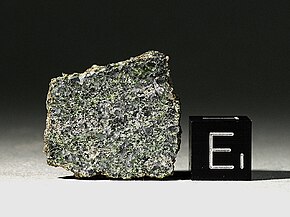Northwest Africa 7325: Difference between revisions
Rescuing 1 sources and tagging 0 as dead. #IABot (v1.6.4) |
|||
| Line 21: | Line 21: | ||
|Image2_caption= |
|Image2_caption= |
||
}} |
}} |
||
'''Northwest Africa 7325''', also known as '''NWA 7325''' is the first [[meteorite]] believed to have originated from [[Mercury (planet)|Mercury]]. Found in a marketplace in [[Erfoud]], [[Morocco]] in April 2012,<ref name="NASA">[http://www.lpi.usra.edu/meteor/metbull.php?code=55627 Northwest Africa 7325]. ''Meteoritical Bulletin Database''. [[Lunar and Planetary Institute]], Houston, Texas. Accessed 2013-03-30.</ref> the meteorite is composed of 35 fragments with a combined weight of approximately {{convert|345|g|oz}}.<ref name="NBC">Major, Jason. March 29, 2013. "[http://www.nbcnews.com/id/50712511/ns/technology_and_science-space/t/greenish-rock-may-be-first-meteorite-mercury/ Greenish rock may be meteorite from Mercury]". ''NBC News''. New York. Accessed 2013-03-30.</ref> Investigation of the meteorite by [[Anthony Irving]] at the [[University of Washington]] determined that the meteorite's composition is consistent with that of Mercury as determined by the [[MESSENGER]] spacecraft.<ref name="NBC"/><ref>{{Cite journal|last1=Irving|first1= A. J. |last2=Kuehner|first2= S. M. |last3=Bunch|first3= T. E. |last4=Ziegler|first4= K. |last5=Chen|first5= G. |last6=Herd|first6= C. D. K. |last7=Conrey|first7= R. M. |last8= Ralew|first8=S.|title = Ungrouped Mafic Achondrite Northwest Africa 7325: A Reduced, Iron-Poor Cumulate Olivine Gabbro from a Differentiated Planetary Parent Body| journal = Proc. 44th Lunar and Planetary Science Conference (2013)|date = March 2013|volume = 1719| pages = 2164|url = http://www.lpi.usra.edu/meetings/lpsc2013/pdf/2164.pdf |bibcode=2013LPICo1719.2164I }}</ref> Irving cautioned, however, that NWA 7325 could also have come from a smaller but Mercury-like body;<ref name="Yahoo">Kramer, Miriam. March 29, 2013. "[https://news.yahoo.com/green-meteorite-may-mercury-first-145455980.html Green Meteorite May Be from Mercury, a First]". ''Yahoo! News''. Accessed 2013-03-30.</ref> an alternative explanation offered is that NWA 7325 may be a [[primitive achondrite]].<ref>{{cite web|url=https://www.sciencenews.org/article/mystery-meteorite|title=Mystery Meteorite: The case for (and against) a rock from Mercury|last=Witze|first=Alexandra|date=June 13, 2013|work=[[Science News]]|accessdate=2014-05-17}}</ref> Notable for its green [[fusion crust]] and high-magnesium/low-iron composition,<ref>{{cite web|url=http://www.skyandtelescope.com/news/home/The-First-Ever-Meteorite-from-Mercury-189374981.html|title=The First-Ever Meteorite from Mercury?|last=Beatty|first=Kelly|date=February 1, 2013|work=[[Sky & Telescope]]|accessdate=2014-05-17| |
'''Northwest Africa 7325''', also known as '''NWA 7325''' is the first [[meteorite]] believed to have originated from [[Mercury (planet)|Mercury]]. Found in a marketplace in [[Erfoud]], [[Morocco]] in April 2012,<ref name="NASA">[http://www.lpi.usra.edu/meteor/metbull.php?code=55627 Northwest Africa 7325]. ''Meteoritical Bulletin Database''. [[Lunar and Planetary Institute]], Houston, Texas. Accessed 2013-03-30.</ref> the meteorite is composed of 35 fragments with a combined weight of approximately {{convert|345|g|oz}}.<ref name="NBC">Major, Jason. March 29, 2013. "[http://www.nbcnews.com/id/50712511/ns/technology_and_science-space/t/greenish-rock-may-be-first-meteorite-mercury/ Greenish rock may be meteorite from Mercury]". ''NBC News''. New York. Accessed 2013-03-30.</ref> Investigation of the meteorite by [[Anthony Irving]] at the [[University of Washington]] determined that the meteorite's composition is consistent with that of Mercury as determined by the [[MESSENGER]] spacecraft.<ref name="NBC"/><ref>{{Cite journal|last1=Irving|first1= A. J. |last2=Kuehner|first2= S. M. |last3=Bunch|first3= T. E. |last4=Ziegler|first4= K. |last5=Chen|first5= G. |last6=Herd|first6= C. D. K. |last7=Conrey|first7= R. M. |last8= Ralew|first8=S.|title = Ungrouped Mafic Achondrite Northwest Africa 7325: A Reduced, Iron-Poor Cumulate Olivine Gabbro from a Differentiated Planetary Parent Body| journal = Proc. 44th Lunar and Planetary Science Conference (2013)|date = March 2013|volume = 1719| pages = 2164|url = http://www.lpi.usra.edu/meetings/lpsc2013/pdf/2164.pdf |bibcode=2013LPICo1719.2164I }}</ref> Irving cautioned, however, that NWA 7325 could also have come from a smaller but Mercury-like body;<ref name="Yahoo">Kramer, Miriam. March 29, 2013. "[https://news.yahoo.com/green-meteorite-may-mercury-first-145455980.html Green Meteorite May Be from Mercury, a First]". ''Yahoo! News''. Accessed 2013-03-30.</ref> an alternative explanation offered is that NWA 7325 may be a [[primitive achondrite]].<ref>{{cite web|url=https://www.sciencenews.org/article/mystery-meteorite|title=Mystery Meteorite: The case for (and against) a rock from Mercury|last=Witze|first=Alexandra|date=June 13, 2013|work=[[Science News]]|accessdate=2014-05-17}}</ref> Notable for its green [[fusion crust]] and high-magnesium/low-iron composition,<ref>{{cite web|url=http://www.skyandtelescope.com/news/home/The-First-Ever-Meteorite-from-Mercury-189374981.html|title=The First-Ever Meteorite from Mercury?|last=Beatty|first=Kelly|date=February 1, 2013|work=[[Sky & Telescope]]|accessdate=2014-05-17|url-status=dead|archiveurl=https://archive.is/20130411204445/http://www.skyandtelescope.com/news/home/The-First-Ever-Meteorite-from-Mercury-189374981.html|archivedate=April 11, 2013}}</ref> NWA 7325 is estimated to be 4.56 billion years old and was likely ejected from Mercury on an Earth-intersecting trajectory by an impact.<ref name="Yahoo"/> |
||
==References== |
==References== |
||
Revision as of 12:19, 24 September 2019
| Northwest Africa 7325 | |
|---|---|
 A 2.810-gram (0.0991 oz) slice of Northwest Africa 7325 with green chromium diopside crystals. Photograph courtesy of Stefan Ralew for the Jared Collins Collection. | |
| Type | Achondrite |
| Country | Morocco |
| Region | Northwest Africa |
| Observed fall | No |
| Found date | 2012 |
| TKW | 345 grams (12.2 oz) |
Northwest Africa 7325, also known as NWA 7325 is the first meteorite believed to have originated from Mercury. Found in a marketplace in Erfoud, Morocco in April 2012,[1] the meteorite is composed of 35 fragments with a combined weight of approximately 345 grams (12.2 oz).[2] Investigation of the meteorite by Anthony Irving at the University of Washington determined that the meteorite's composition is consistent with that of Mercury as determined by the MESSENGER spacecraft.[2][3] Irving cautioned, however, that NWA 7325 could also have come from a smaller but Mercury-like body;[4] an alternative explanation offered is that NWA 7325 may be a primitive achondrite.[5] Notable for its green fusion crust and high-magnesium/low-iron composition,[6] NWA 7325 is estimated to be 4.56 billion years old and was likely ejected from Mercury on an Earth-intersecting trajectory by an impact.[4]
References
- ^ Northwest Africa 7325. Meteoritical Bulletin Database. Lunar and Planetary Institute, Houston, Texas. Accessed 2013-03-30.
- ^ a b Major, Jason. March 29, 2013. "Greenish rock may be meteorite from Mercury". NBC News. New York. Accessed 2013-03-30.
- ^ Irving, A. J.; Kuehner, S. M.; Bunch, T. E.; Ziegler, K.; Chen, G.; Herd, C. D. K.; Conrey, R. M.; Ralew, S. (March 2013). "Ungrouped Mafic Achondrite Northwest Africa 7325: A Reduced, Iron-Poor Cumulate Olivine Gabbro from a Differentiated Planetary Parent Body" (PDF). Proc. 44th Lunar and Planetary Science Conference (2013). 1719: 2164. Bibcode:2013LPICo1719.2164I.
- ^ a b Kramer, Miriam. March 29, 2013. "Green Meteorite May Be from Mercury, a First". Yahoo! News. Accessed 2013-03-30.
- ^ Witze, Alexandra (June 13, 2013). "Mystery Meteorite: The case for (and against) a rock from Mercury". Science News. Retrieved 2014-05-17.
- ^ Beatty, Kelly (February 1, 2013). "The First-Ever Meteorite from Mercury?". Sky & Telescope. Archived from the original on April 11, 2013. Retrieved 2014-05-17.
